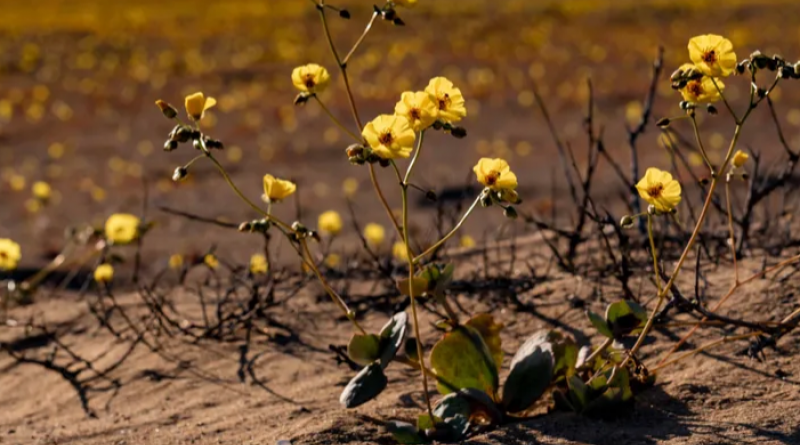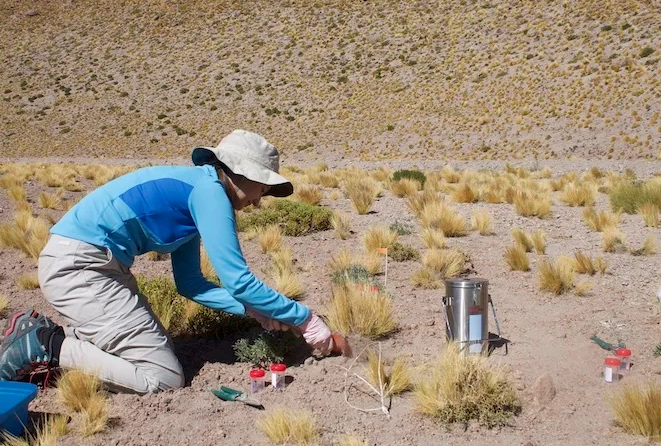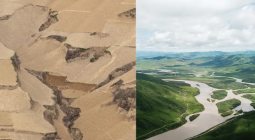This Desert May Contain Secrets To Avoiding Climate Famine

A landmark new study of plant life in one of the world’s driest places could yield new drought-resistant crops — if mining for electric vehicle batteries doesn't destroy the ecosystems first.
From space, South America’s Atacama Desert looks like a craggy patch of lifeless brown stretching 49,000 square miles near Chile’s northern tip. At 7,900 feet above sea level, the parched, windswept landscape broils under the sun. It’s the world’s oldest and driest desert.
Average rainfall totals little more than 0.04 inches per year, and yet plant life adorns the area in what would be the ear-shaped continent’s tragus with indigo cones of Lupinus oreophilus flowers, lime-green blobs of Azorella atacamensis, and Solanum chilense ― wild tomatoes that, when ripe, look like little dark plums.
For 10 years, Rodrigo Gutiérrez made routine trips 1,000 miles north from his laboratory at Pontificia Universidad Católica de Chile in the capital city of Santiago to 22 separate sites in the desert, where he measured the temperature and water, and collected samples of plants, soils and the microbes that cling to both. The molecular biologist then partnered with scientists from across the hemisphere and disciplines ― botanists, microbiologists, ecologists ― to decode the plants’ genes and learn how they adapted to survive in an environment extreme enough to challenge his own physical stamina.
On Monday, Gutiérrez and 26 of his colleagues published nearly 300 genetic discoveries in a peer-reviewed paper in the prestigious Proceedings of the National Academy of Sciences. What they found could contain the secrets to avoiding food shortages in an increasingly hot, drought-prone world, providing scientists the genetic tools to breed resilient new crops.
“With the population we have, we need to produce food and crops despite increasing desertification,” Gutiérrez said. “The only way we’ll be able to do that is if we can engineer some kind of tolerance to drought in crops.”
But the findings also come as a warning of what could be lost as the global economy curbs its appetite for fossil fuels with solar panels and batteries made of lithium and copper, vast quantities of which are mined in the mineral-rich Atacama Desert.
The different, and in some ways conflicting, resources for a hotter world highlight the tradeoffs of the energy transition, and give weight to environmentalists’ pleas for a new green industrial boom to avoid replicating the ecological recklessness of its fossil-fueled forerunner. Surging demand for the Atacama’s geological treasures threatens to drain what little water sustains the desert’s complex webs of life faster than nature can adapt. The region already supplies upward of 30% of the world’s lithium, a compound so desired in the green economy it’s sometimes called “white gold,” and Chile’s government is looking to expand production. Climate change, meanwhile, is only adding pressure, making the Atacama even drier than in years past.
A Cross-Continental, Cross-Disciplinary Triumph
The study is as much a triumph of collaboration between continents as disciplines. The Chilean researcher collected samples of 32 dominant plant species in the Atacama, stored them in liquid nitrogen, then sequenced their RNA back at the lab in Santiago.
Meanwhile, researchers at New York University and the American Museum of Natural History were assembling a computer matrix of ancient plant genes, and tapping New York Botanical Garden experts to identify 32 genetically similar “sister” species to match the Atacama samples. Plugging that mountain of data into NYU’s in-house supercomputers, the scientists started performing what’s called a phylogenomic analysis to reconstruct an evolutionary history and pinpoint which genetic proteins helped the flora survive in the desert’s harsh climate.
Crunching nearly 1.7 million protein sequences and close to 8.6 million amino acids across more than 70 species, the resulting analysis zeroed in on 265 separate genes whose protein sequences mutated as the plants evolved to live in the Atacama, including those that made it easier to survive under high-light radiation, in long periods without water, and in salty and nitrogen-poor soil.
To test how the genes worked, the researchers then crosschecked them with related genes in the widely studied model species Arabidopsis, a flowering Eurasian plant known as thale cress, confirming that they did, in fact, play a role in function such as managing the sun’s radiation and dealing with extreme temperatures.
“It’s a mine, but it’s also a genetic goldmine,” said Gloria Coruzzi, a molecular biologist at New York University who helped sequence the plants’ genomes and co-authored the study, referring to the lithium and copper production in the region. “We’re extracting the genes that enable the plants to grow in that desperate environment.”
The findings were not limited to genetics alone. The scientists also identified microbes in the soil that pulled nitrogen from the air into the soil, providing the scarce nutrient to the plants’ roots. At a time when scientists and Silicon Valley startups are seeking new ways to wean U.S. farmers off their addiction to nitrogen fertilizer, which pollutes water and produces large amounts of planet-heating gas.

Those microbes, Coruzzi said, are the “ecological context of how these plants are growing,” a key detail as the soil microbiome is increasingly seen as “the future of plant agriculture.”
About 44% of the world’s croplands are in drylands, ecosystems that include deserts, semi-deserts and grasslands, according to United Nations data. And many of the world’s deserts are growing as the planet warms and freshwater resources diminish. Africa’s Sahara, for example, has expanded by 10% since 1920, recent research found, threatening crop fields that feed a population that is expected to double by the middle of this century.
The potential applications stretch beyond drought-resistant tomatoes or corn that requires far less nitrogen fertilizer. Protein sequences in grasses the scientists studied could be used to grow biofuel crops in soils too poor for vegetable farming. The U.S. Department of Energy gave the researchers $7 million to conduct the study for those purposes specifically. (The Chilean government also gave the project “substantial funding,” though the researchers declined to give an exact dollar figure.)
‘These Ecosystems Are Unrepeatable’
To get a sense of just how rapidly lithium production in the Atacama has increased, you only need to look at satellite images of the desert’s biggest salt flat. In 1993, industry on the Salar de Atacama was confined to a tiny sliver of the nearly 1,200-square-mile flatland surrounded by mountains. By 2015, U.S. Geological Survey images show production sites had consumed a broad swath of the flat’s central zone.
“It’s a mine, but it’s also a genetic goldmine.”
- Gloria Coruzzi, molecular biologist at New York University
The expansion reflects growing demand overseas. While Australia, which mines lithium from hard rock and sends the raw material to China for processing, has in recent years become the world’s top supplier of the mineral, the Atacama remains a central node in a supply chain increasingly pulled taut as electric vehicle sales soar in East Asia, Europe, and North America.
By 2040, the International Energy Agency predicts demand for lithium will be 42 times what it was in 2020.
Lithium miners and vehicle battery manufacturers have long worried that the supply of the mineral would run short sometime in the next decade. But as sales have skyrocketed and commodity producers have struggled to keep up with post-pandemic supply orders, some have begun to warn that the lithium crunch could hit as soon as two years from now.
After years of becoming cheaper by the month, battery prices last week slowed their steady descent for the first time.
For environmental and indigenous activists in Chile, those concerns have been central as the country rewrites its constitution in a bid to restore balance power away from the corporations that have dominated society there since the reign of dictator Augusto Pinochet.
“This report confirms these activists’ sentiments that there is a lot of value for humanity writ large in preserving the ecosystem and ensuring that extraction doesn’t take precedence over other land uses and livelihoods in the area,” said Thea Riofrancos, a political scientist at Providence College who studies lithium mining and its impacts in Latin America. “The big story here is about the contradiction between local landscapes and the scientific value of them and extractive activities.”
The study “highlights the importance of understanding and valuing local and endemic biodiversity,” said Cristina Dorador, a microbial ecologist at Chile’s Universidad de Antofagasta who was not involved in the paper but reviewed an advanced copy of the paper for HuffPost.
“The fragile equilibrium of the Salar de Atacama and its surroundings is at risk due to massive scale of the proposed extraction,” said Dorador, who is also an activist working on the country’s new constitution.
Juan Navedo, a researcher at the Universidad Austral de Chile, said “all food crops would benefit from knowledge about adaptations in vascular plants and associated soil microbiota” from the study, and warned that “once water has gone, restoration is unfeasible.”
“These ecosystems must be untouchable if we are to survive as a civilization,” Navedo, who was not involved in the paper but reviewed it for HuffPost, wrote in an email. “These ecosystems and their associated biodiversity are unrepeatable.”
Similar conflicts are brewing now in the United States, where demand for lithium and other raw materials for green technologies is driving a push to increase domestic mining. In Nevada, a proposed lithium mine has drawn heated opposition from Indigenous tribes, ranchers and botanists, who say the project threatens an ecologically and culturally precious area.
Gutiérrez hopes his study could serve as a model for future ecosystem-wide research.
“Most of what we know about biology comes from a very small number of organisms that we use in the labs, when there’s so much to know and learn from wild species in their environments,” he said. “If you’re going to start mining in a place and you don’t even know what’s there, we’ll have no idea what we’ve lost afterward.”
HUFFPOST




